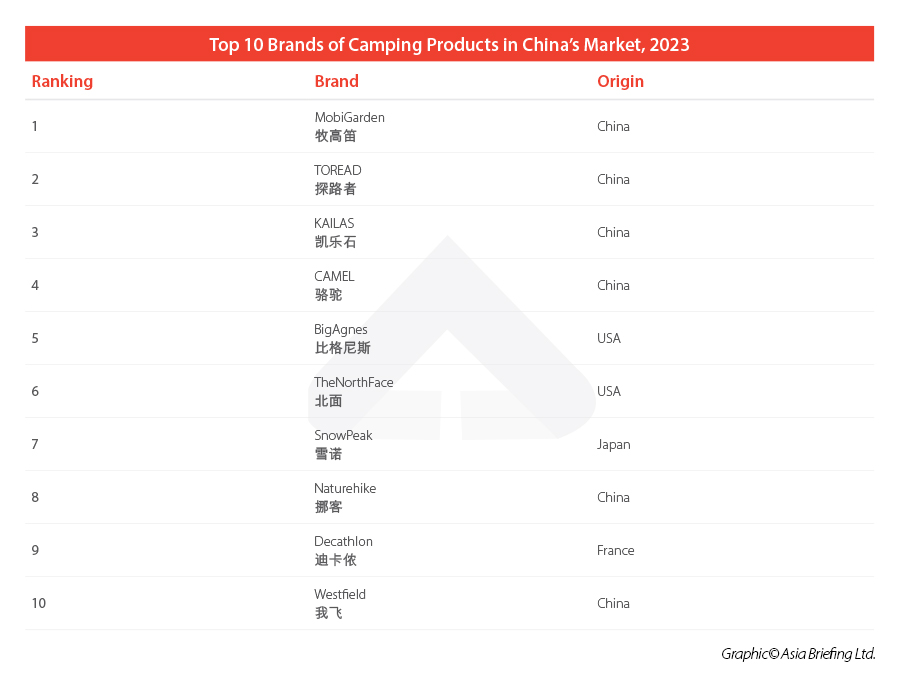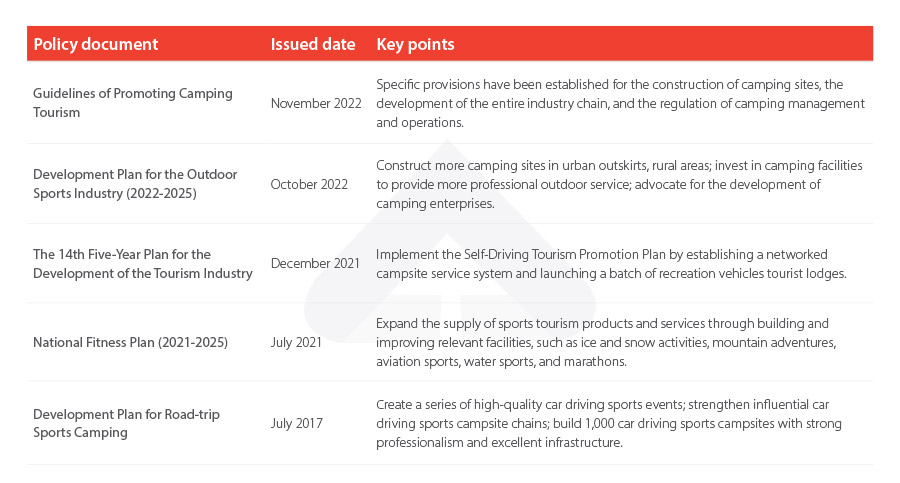Unleashing the Potential: Exploring China’s Booming Camping Market and Foreign Investment Opportunities
In recent years, China has witnessed a surge in interest in outdoor activities, particularly camping, driven by nationwide fitness policies and the impact of the pandemic. This surge has led to a significant increase in the demand for camping equipment, propelling the industry’s rapid growth and sustained upward trajectory. Projections indicate that by 2025, the camping economy in China will reach an estimated value of RMB 1.44 trillion (US$202.04 billion).
While China currently has a participation rate of around 10 percent in outdoor activities, which is significantly lower than the rates of over 50 percent observed in countries like the United States, the revival of the outdoor industry in China has led to the growing popularity of camping. Thanks to its varied recreational opportunities and relatively accessible entry requirements, camping is helping to bridge the divide and reduce the disparity in engagement rates between China and developed Western nations.
This article discusses recent policies to promote the camping industry in China. It also delves into market trends and opportunities for foreign direct investment (FDI).
Overview of China’s camping market
With a rising interest in outdoor activities and a growing appreciation for nature, Chinese consumers are increasingly embracing the camping experience. As the government invests in camping infrastructure and drafts supportive policies, the market is poised for further development, making it an attractive prospect for businesses and investors alike.
Market scale and future potential
According to the latest Report on Analysis of the Camping Industry in China, the core market size of the camping economy in 2022 reached RMB 113.47 billion (US$15.92 billion), with a notable year-on-year growth rate of 51.8 percent. This impressive growth further propelled the peripheral market to RMB 581.61 billion (US$81.59 billion), exhibiting a significant year-on-year growth rate of 52.6 percent.
The upward trend in the camping industry is expected to continue, with projections indicating that by 2025 the core market size of the camping industry will further rise to RMB 248.32 billion (US$34.83 billion). This substantial growth will also drive the peripheral market to reach an estimated RMB 1.44 trillion (US$202.04 billion).
These figures demonstrate the robust and promising trajectory of the camping industry in China. The remarkable growth rates suggest increasing consumer interest and participation in camping activities, contributing to the overall expansion of the market. As more consumers embrace camping as a preferred leisure option, opportunities for investment and further development within the industry are likely to emerge.
Industry development and leading brands
Data shows that as of 2021, China had a total of 68,700 existing camping-related enterprises. These enterprises can include manufacturers and retailers of camping equipment, camping gear rental companies, camping tour operators, campsite developers and operators, outdoor adventure companies, and other businesses that cater to the needs of campers and outdoor enthusiasts. There has been a consistent increase in the number of registered camping-related enterprises in China. The figure has grown from 464 companies in 2012 to 22,214 companies in 2021, achieving a compound annual growth rate (CAGR) of 53.7 percent.
Looking at the competitive landscape, the top 10 camping brands in China reveal a balance between domestic and international players. In terms of market share, Chinese domestic brands have a stronghold in the vast majority of the mid-to-low-end market segments and a portion of the mid-to-high-end segments. Conversely, a significant number of international brands position themselves primarily in the mid-to-high-end market.
However, in recent years, the rapid growth of local enterprises, such as MobiGarden and TOREAD, has increased the market share of domestic brands in the mid-to-high-end market segment. This trend signifies the growing competitiveness of local players within the China camping industry.
Major types of camping tourism in China
Generally, camping can be categorized into three modes in China:
- Traditional camping: Consumers bring basic facilities, such as tents, sleeping bags, and portable tables and chairs, aiming for a safe, convenient, and cost-effective camping experience.
- Glamping: ‘Glamourous camping’, where consumers typically require more equipment, such as camping lights, portable coffee makers, outdoor refrigerators, outdoor air conditioners, cartridge stoves, foldable tables, barbecue tools, and travel tea sets. This results in higher expenses compared to traditional camping.
- RV camping: The RV market in China remains relatively small compared to that in developed regions, such as the US and Europe. However, it holds immense potential for future development.
Alongside essential camping equipment like chairs and tents, glamping has witnessed the introduction of a myriad of products aimed at satisfying diverse consumer demands. According to research from e-commerce platform JD.com conducted in 2022, online sales of camping lights experienced a notable surge of 52 percent compared to the previous year, while sales of camping cookware soared by an impressive 214 percent, and camping electronic appliances saw a substantial increase of 152 percent.
The significant growth of glamping reflects a shift in consumer preferences, as they prioritize comfortable experiences and the creation of a pleasant atmosphere rather than solely relying on specialized equipment. This transformation has brought about a greater emphasis on emotional consumption throughout the camping journey.
State policies shaping China’s camping industry
The Chinese government is actively promoting the development of the camping industry and has recently released several policy documents to support outdoor sports and fitness activities.
These measures send a positive signal to the industry, indicating the commitment to enhancing the variety of camping products and stimulating the consumption of camping tourism. Collectively, these preferable policies focus on four key areas to optimize camping products and services:
- Improving camping facilities: Encourage local authorities and park management teams to enhance the camping facilities in suburban parks. This includes the establishment of designated camping areas, installation of appropriate amenities, and provision of adequate security measures to ensure camper safety.
- Expanding outdoor recreational activities: Advocate for the integration of additional outdoor sports and recreational activities in the vicinity of camping sites. This could involve the development of hiking trails, walking paths, biking routes, and other relevant facilities that enable campers to engage in various outdoor pursuits.
- Accelerating infrastructure development: Expedite the construction and maintenance of essential facilities. This includes upgrading roadways, improving access points, establishing information centers, and implementing waste management systems that promote environmental sustainability.
- Collaboration with outdoor equipment companies: Encourage outdoor equipment companies to focus on designing and manufacturing camping gear tailored to different user preferences and demographics. This can range from high-quality tents, sleeping bags, and cookware to innovative camping technologies that enhance the overall camping experience.
It is foreseeable that in the coming years, government agencies will intensify efforts to establish and enforce standardized norms for the construction and operation of camping sites, thereby deepening regulatory oversight. This will further enhance consumer confidence in camping sites, unlock market consumption potential, and yield tangible returns on investment for stakeholders.
Emerging regulations on camping sites
Since May 2023, first-tier cities in China, such as Beijing, Shanghai, and Guangzhou, have successively released detailed regulations for the management of camping sites. These regulations provide specific requirements for the selection and location of campsites, safety measures, environmental hygiene, and facilities and equipment.
- Beijing: Opinions on Standardizing and Guiding the Development of Camping Sites. The document outlines 20 specific safety requirements, including the selection of camping site locations, standardized construction of safety production, safety management systems, risk identification, hazard inspections, personnel registration, fire safety, flood season safety, extreme weather response, safety agreements, education and training, limited reservations, emergency management, staffing, entrance and exit management, fencing and warning signs, emergency broadcasting, video surveillance, medical rescue, and insurance services.
- Shanghai: Opinions on the Management of Camping Sites in Shanghai. The guidelines specify the management requirements for camping sites, including site selection, site operation, safety management, and ecological and environmental protection. At the same time, it encourages the integration of camping with rural resources, outdoor sports, nature education, and leisure and wellness activities to create high-quality products.
- Guangzhou: The List of Open and Shared Areas in Guangzhou’s Parks and Green Spaces. The announcement specifies 82 lawns and shaded areas in Guangzhou where tents can be pitched, further expanding the shared spaces and types of open areas in parks and green spaces.
Overall, these developments indicate a growing recognition of the importance of regulating and promoting safe and sustainable camping practices, which can inspire other cities to follow suit and develop their own regulations in the future.
Diversified business modes of camping sites
Currently, the integration of camping with various cultural and entertainment industries has become a major trend. In addition to traditional camping combined with natural scenery, a wide variety of innovative camping and leisure activities are emerging.
- Camping + artistic performance: Camping site operators collaborate with cultural and art institutions to combine camping experiences with art events, music festivals, and sports competitions.
- Camping + adventure sports: Integrating activities such as skydiving, rock climbing, kayaking, and other extreme sports to attract outdoor sports enthusiasts to campsites.
- Camping + children’s education: Camping sites offer a series of parent-child educational activities aimed at fostering children’s connection with nature, developing their understanding of the natural environment, and enhancing their outdoor survival skills.
Opportunities for foreign investors
As the camping industry in China continues to grow at a rapid pace, foreign investors have the opportunity to tap into specific market segments, develop differentiated products and services, and capitalize on the immense potential of China’s camping market.
According to the latest Catalogue of Encouraged Industries for Foreign Investment (2022 Version), foreign investors are encouraged to invest in multiple sectors related to camping products and services, such as:
- Development of tourism infrastructure and provision of tourism information services.
- Construction, operation, and management of outdoor sports facilities and fitness venues, such as sports campsites.
- Research, popularization, and promotion of sports products and services.
Foreign investors will need to strategically focus on specific camping market segments and strive to develop differentiated products, services, and unique branding.
Adopting a differentiated approach entails two key aspects:
- Identifying and targeting emerging market segments, such as glamping, and allocating resources towards the research and development of camping-related products that cater to diverse camping scenarios.
- Leveraging the available campsite resources to offer a range of distinctive services, thereby avoiding redundant and low-value offerings. An illustrative example is the adoption of the “camping +” concept, which can generate economic synergies and facilitate the creation of distinctive campsites and innovative camping projects.
In summary, the rapid growth of China’s camping industry, coupled with the rising demand for camping products and services, presents lucrative opportunities for foreign investors. By strategically investing and leveraging campsite resources, foreign investors can establish a strong foothold in this thriving market. Aligning with emerging trends and catering to the evolving needs of Chinese campers will be key to achieving success and capitalizing on the immense potential of China’s camping industry.
About Us
China Briefing is written and produced by Dezan Shira & Associates. The practice assists foreign investors into China and has done so since 1992 through offices in Beijing, Tianjin, Dalian, Qingdao, Shanghai, Hangzhou, Ningbo, Suzhou, Guangzhou, Dongguan, Zhongshan, Shenzhen, and Hong Kong.
Please contact the firm for assistance in China at china@dezshira.com. Dezan Shira & Associates has offices in Vietnam, Indonesia, Singapore, United States, Germany, Italy, India, Dubai (UAE), and Russia, in addition to our trade research facilities along the Belt & Road Initiative. We also have partner firms assisting foreign investors in The Philippines, Malaysia, Thailand, Bangladesh.
- Previous Article Shanghai Looks to Attract Foreign Investors with New Measures
- Next Article Investing in Deyang: Industry, Economics and Policy










